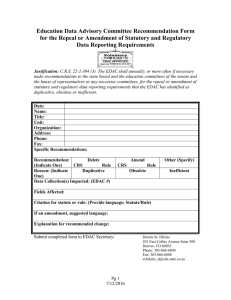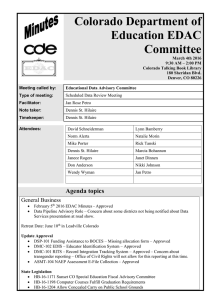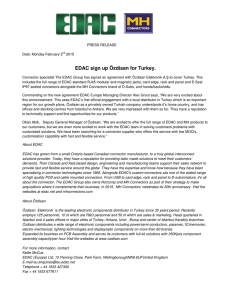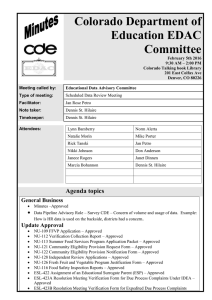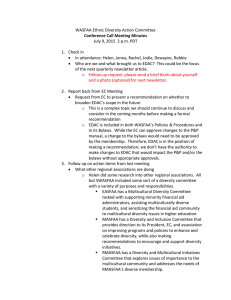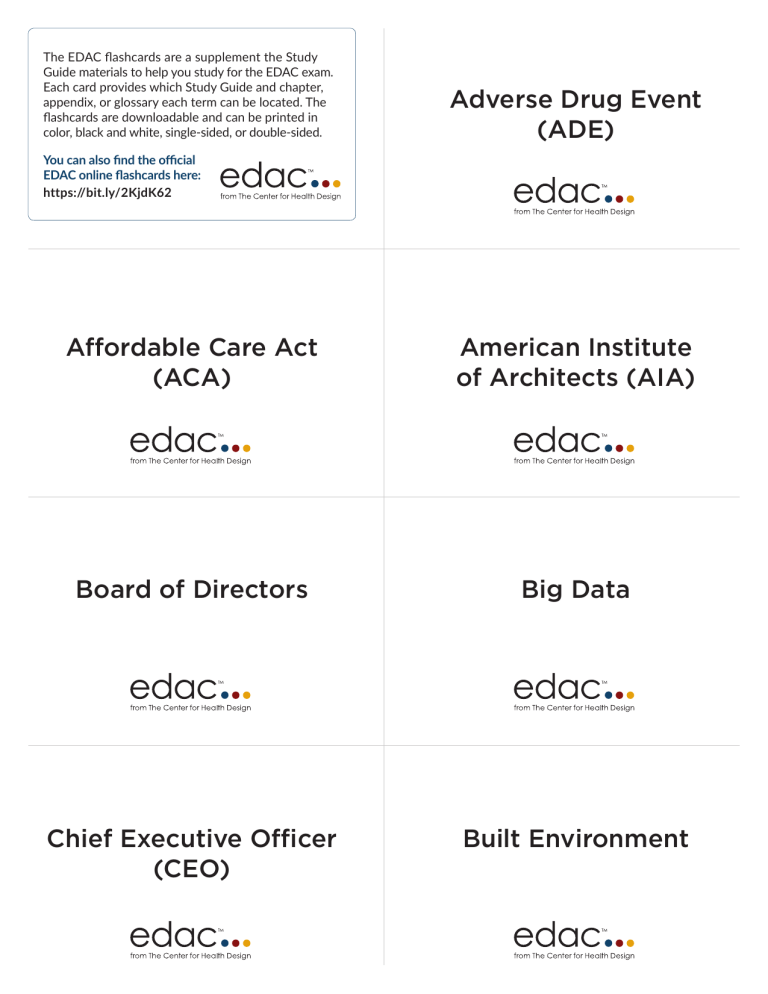
The EDAC flashcards are a supplement the Study Guide materials to help you study for the EDAC exam. Each card provides which Study Guide and chapter, appendix, or glossary each term can be located. The flashcards are downloadable and can be printed in color, black and white, single-sided, or double-sided. Adverse Drug Event (ADE) You can also find the official EDAC online flashcards here: https://bit.ly/2KjdK62 Affordable Care Act (ACA) American Institute of Architects (AIA) Board of Directors Big Data Chief Executive Officer (CEO) Built Environment ADVERSE DRUG EVENT (ADE) - Generally unwanted, negative consequences associated with the use of given medications; any injuries resulting from medication use, including physical harm, mental harm, or loss of function. EDAC Study Guide 1 2 3 Chapter 1 2 Thank you to our EDAC Educational Partner 3 4 AMERICAN INSTITUTE OF ARCHITECTS (AIA) The leading professional membership association for licensed architects, emerging professionals, and allied partners since 1857. EDAC Study Guide 1 2 3 AFFORDABLE CARE ACT (ACA) - The Patient Protection and Affordable Care Act, commonly called the Affordable Care Act (ACA), is a federal statute signed into law by President Barack Obama on March 23, 2010 to increase access to quality, affordable healthcare for all Americans and expand Medicaid coverage. GLOSSARY BIG DATA - An evolving term that describes any voluminous amount of structured, semi-structured, and unstructured data that has the potential to be mined for information. EDAC Study Guide 1 2 3 Chapter 1 2 3 4 BUILT ENVIRONMENT - Man-made surroundings where human activity occurs; the humanitarianmade space in which people live, work, and recreate on a day-to-day basis. EDAC Study Guide 1 2 3 GLOSSARY EDAC Study Guide 1 2 3 Chapter 1 2 3 4 BOARD OF DIRECTORS - For-profit, nonprofit, and governmental boards exist in healthcare, depending on whether the type of organization is investor owned, not-for-profit community based, or operated by a government agency. These boards are ultimately accountable for organizational activity, accomplishments, and major capital investments. One of the most important functions of a board is to select the chief executive officer (CEO), who is also a member of the board. EDAC Study Guide 1 2 3 Chapter 1 2 3 4 CHIEF EXECUTIVE OFFICER (CEO) - The CEO is a key decision-maker who aids the board in creating a future vision for the organization, which may include a building project. Accountable for all services and behaviors of the organization; in fact, s/he is responsible for everything but the board of directors and its functions. S/he receives his or her annual performance review from and is accountable to the board based on the overall performance of the organization. EDAC Study Guide 1 2 3 Chapter 1 2 3 4 Credibility Construction Phase Environment Of Care (EOC) Design Guidelines Evidence-Based Design (EBD) Evidence Fable Hospital Evidence-Based Design Process CREDIBILITY - The hierarchy of credible evidence varies widely depending upon the quality of research components (e.g., research design and measurement tools) and the impact of potential biases (threats to credibility) embedded in research works. Where research is published also reflects credibility. To understand if the evidence is credible and should be used to inform the hypotheses, it is important to understand the relevance, rigor, validity, and generalizability of the evidence. CONSTRUCTION PHASE - This phase includes the following: complete the bid, negotiation, and award process; monitor implementation of construction; finalize the research plan; prepare for occupancy; and commissioning. EDAC Study Guide 1 2 3 Chapter 1 2 3 4 DESIGN GUIDELINES - Aligned with the goals of the organization, as well as the project-specific goals, these guidelines are summary statements that designers turn to for guiding aesthetic, functional, or compositional decisions. These guidelines are distilled from sources of relevant evidence. EDAC Study Guide 1 2 3 Chapter 1 2 3 1 2 3 Chapter 1 2 3 4 1 2 3 Chapter 1 2 3 2 3 Chapter 1 2 3 4 EDAC Study Guide 1 2 3 Chapter 1 2 3 4 3 4 EVIDENCE-BASED DESIGN (EBD) - The process of basing decisions about the built environment on credible research to achieve the best possible outcomes. 4 EVIDENCE-BASED DESIGN PROCESS - An eight step process to implement EBD. Developed by The Center for Health Design along with experts and volunteers, the steps are: define EBD goals and objectives; find sources for relevant evidence; critically interpret relevant evidence; create and innovate EBD concepts; develop a hypothesis; collect baseline measures; monitor implementation of design and construction; and measure post-occupancy performance results. EDAC Study Guide 1 ENVIRONMENT OF CARE (EOC) - The experience a person has in a healthcare delivery system as a result of the relationship between six components: physical environment, layout and operations, systems, people, concepts, and implementation. These components should be considered concurrently. EVIDENCE - Refers to information gleaned from published research studies, professional practice articles, and best practice reports in response to a research question prompted by a design challenge. EDAC Study Guide EDAC Study Guide 4 EDAC Study Guide 1 2 3 Chapter 1 2 FABLE HOSPITAL - Developed in 2004 and updated in 2011, the Fable Hospital is a hypothetical study developed to illustrate the business case and the return on investment by implementing design strategies to improve outcomes. EDAC Study Guide 1 2 3 Chapter 1 2 3 4 Healing Environments Hospital Consumer Assessment of Healthcare Providers and Systems (HCAHPS) Healthcare-Associated Infection (HAI) Hospital-Acquired Condition (HAC) Healthcare Information Technology (HIT) Health Insurance Portability and Accountability Act (HIPAA) Institute For Healthcare Improvement (IHI) Institute of Medicine – Crossing the Quality Chasm HOSPITAL CONSUMER ASSESSMENT OF HEALTHCARE PROVIDERS AND SYSTEMS (HCAHPS) - The first national, standardized, publicly-reported survey of patients’ perspectives of hospital care. Changes in reimbursement models are linked to HCAHPS scores. EDAC Study Guide 1 2 3 HEALING ENVIRONMENTS - A healthcare environment that has specific features designed to help reduce stress, enhance the healing process, and minimize the risk of injury and medical errors. GLOSSARY HOSPITAL-ACQUIRED CONDITION (HAC) A condition or complication that a patient develops during a hospital stay that was not present at admission. EDAC Study Guide 1 2 3 Chapter 1 1 2 3 2 3 4 GLOSSARY INSTITUTE OF MEDICINE – CROSSING THE QUALITY CHASM - This report from the committee on the Quality of Health Care in America made an urgent call for fundamental change to close the quality gap, recommended a redesign of the American healthcare system, and provided overarching principles for specific direction for policymakers, healthcare leaders, clinicians, regulators, purchasers, and others. EDAC Study Guide 1 2 3 Chapter 1 1 2 3 Chapter 1 2 3 4 HEALTHCARE-ASSOCIATED INFECTION (HAI) – An infection that is acquired while receiving treatment for another condition in a healthcare setting. HEALTH INSURANCE PORTABILITY AND ACCOUNTABILITY ACT (HIPAA) - A mandate to improve efficiency by standardizing electronic data exchange, and the protection of confidentiality and security of health data by setting and enforcing standards. Healthcare environments contribute to HIPAA compliance with design strategies and features that increase patient privacy while encouraging patient to care provider communications. EDAC Study Guide EDAC Study Guide 2 3 4 EDAC Study Guide 1 2 3 GLOSSARY HEALTHCARE INFORMATION TECHNOLOGY (HIT) - The umbrella framework to describe the comprehensive management of health information and its secure exchange between consumers, providers, government and quality entities, and insurers. EDAC Study Guide 1 2 3 GLOSSARY INSTITUTE FOR HEALTHCARE IMPROVEMENT (IHI) - In the late 1980s, the IHI, led by Dr. Don Berwick and others, was committed to redesigning healthcare into a system without errors, waste, delay, and unsustainable costs. Today they are an influential force in the U.S. and worldwide, and have created the Triple Aim framework for optimizing health system performance. EDAC Study Guide 1 2 3 Chapter 1 2 3 4 Methicillin-resistant Staphylococcus aureus (MRSA) Leadership in Energy and Environmental Design (LEED) Operational Plan Meaningful Use Partnership For Patients (PfP) Outcomes Pay For Performance Patient-Centered Medical Home LEADERSHIP IN ENERGY AND ENVIRONMENTAL DESIGN (LEED) - A green building certification program, LEED recognizes best-in-class building strategies and practices. EDAC Study Guide 1 2 3 Chapter 1 2 3 METHICILLIN-RESISTANT STAPHYLOCCOCUS AUREUS (MRSA) - A type of bacteria that has become resistant to many of the antibiotics used to treat ordinary staph infections. MRSA is responsible for several difficult-to-treat infections in humans. 4 MEANINGFUL USE - A minimum standard for using certified electronic health record technology to improve quality, safety, efficiency, and reduce health disparities. The standard is set to measure in three stages: engage patients and family; improve care coordination, population, and public health; and maintain privacy and security of patient health information. EDAC Study Guide 1 2 3 GLOSSARY OUTCOMES - Changes in health status, usually due to an intervention (e.g., adding handrails to headwall). Achieving good patient health outcomes is the fundamental purpose of healthcare. This can be applied to individuals as well as populations. Many target outcomes for a healthcare organization can be linked to the built environment. EDAC Study Guide 1 2 3 1 2 3 GLOSSARY Chapter 1 2 3 1 2 3 GLOSSARY OPERATIONAL PLAN - A coordinated plan between operations and the architectural design to achieve a systems-based perspective. Every department within a healthcare setting may experience significant changes in the way care is delivered as a result of new workflows and updated technology systems. EDAC Study Guide 1 2 3 Chapter 1 2 3 4 3 4 PARTNERSHIP FOR PATIENTS (PfP) A public-private partnership, launched by the Centers for Medicare and Medicaid Services, working to improve the quality, safety, and affordability of healthcare for all Americans. The PfP includes Hospital Engagement Networks (HENs) and has 10 core patient safety goals. PATIENT-CENTERED MEDICAL HOME - A care delivery model whereby patient treatment is coordinated through their primary care physician to ensure they receive the necessary care when and where they need it, in a manner they can understand. EDAC Study Guide EDAC Study Guide EDAC Study Guide 1 2 3 Chapter 1 2 PAY FOR PERFORMANCE - A method to foster quality performance by providing pay incentives or bonuses for quality work. Also known as “value-based purchasing,” a payment model that offers financial incentives to physicians, hospitals, medical groups, and other healthcare providers for meeting certain performance measures. 4 EDAC Study Guide 1 2 3 GLOSSARY Peer-Reviewed Journal Pebble Project Population Health Planetree Model Public-Private Partnership Pre-Design Phase Stakeholders Serious Reportable Event (SRE) PEBBLE PROJECT - A joint research effort between The Center for Health Design and a healthcare organization to demonstrate how that organization has improved outcomes using an evidence-based design process. EDAC Study Guide 1 2 3 Chapter 1 2 3 PEER-REVIEWED JOURNAL - A scholarly periodical that requires each article submitted for publication be reviewed and assessed by an independent panel of experts. 4 PLANETREE MODEL - An approach that guides organizations in making patient-centered care the centerpiece of a cohesive strategy that accelerates quality improvement and positions them to create lasting change. EDAC Study Guide 1 2 3 1 2 3 GLOSSARY Chapter 1 2 1 2 3 Chapter 1 2 2 3 GLOSSARY 3 3 EDAC Study Guide 1 2 3 Chapter 1 2 3 4 PUBLIC-PRIVATE PARTNERSHIP - A government service or private business venture that is funded and operated through a partnership of government and one or more private sector companies. 4 SERIOUS REPORTABLE EVENT (SRE) - An incident involving death or serious harm to a patient resulting from a lapse or error in a healthcare facility. EDAC Study Guide 1 POPULATION HEALTH - The overall health of a population, as well as the distribution of health. It is an approach to health that aims to improve the health of an entire human population or the health outcomes of a group of individuals, including the distribution of such outcomes within the group. PRE-DESIGN PHASE - The initial phase of a project’s design process that results in the determination of the alignment, layout, and technology for the project. EDAC Study Guide EDAC Study Guide EDAC Study Guide 1 2 3 Chapter 1 2 3 4 2 3 4 STAKEHOLDERS - Individuals with a vested interest in a project or those involved with the implementation of the project who care about its success. 4 EDAC Study Guide 1 2 3 Chapter 1 Triple Aim Sustainability Value Engineering Value-Based Purchasing Wayfinding Vision Basic (Academic) Research Applied Research SUSTAINABILITY - The quality of not being harmful to the environment or depleting natural resources, and thereby supporting long-term ecological balance. EDAC Study Guide 1 2 3 Chapter 1 TRIPLE AIM - A framework developed by The Institute for Healthcare Improvement that describes an approach to optimizing health system performance. Three dimensions are included in the Triple Aim: improving the patient experience of care, improving the health of populations, and reducing the per capita cost of healthcare. 2 3 4 VALUE-BASED PURCHASING - A shift from paying for volume to payment for quality (also called pay for performance). Hospitals are paid for inpatient acute care services based on the quality of care, not just quantity of the services they provide. EDAC Study Guide 1 2 3 Chapter 1 2 3 1 2 3 Chapter 1 2 3 4 4 1 2 3 Chapter 1 2 3 Chapter 1 2 3 4 EDAC Study Guide 1 2 3 Chapter 1 2 3 4 WAYFINDING - In the context of architecture, refers to the user’s experience of orientation and choosing a path within the built environment, and refers to information or systems that guide people through a physical environment to enhance their understanding and experience of the space. 5 APPLIED RESEARCH - Usually originates from the need to solve a practical problem and is intended for direct and immediate application to improve real-life conditions. EDAC Study Guide 1 VALUE ENGINEERING - A systematic method to improve the value of the facility by using an examination of function. Value can be increased by either improving the function or reducing the cost. VISION - Articulates the intentions of the project, the direction in which the project needs to head, the business data supporting the investment in new capital construction, and the target objectives of the project. EDAC Study Guide EDAC Study Guide EDAC Study Guide 1 2 3 GLOSSARY BASIC (ACADEMIC) RESEARCH – Typically originates from curiosity and aims at creating new knowledge or adding to the existing knowledge. While basic research can be applied later, it is still considered basic because the researchers have little or no intention of practical usage. 2 3 EDAC Study Guide 1 2 3 Chapter 1 2 3 Confounding Variables Bias Databases Correlational Study Design Strategy Dependent Variable Experimental Design/Randomized Control Trials Ethnographic Study BIAS - Prejudice in favor of or against one thing, person, or group compared with another, usually in a way considered to be unfair. EDAC Study Guide 1 2 3 Chapter 1 2 CONFOUNDING VARIABLES - Extraneous variables not under the control of the experimenter that vary systematically from the independent variable, making it difficult to isolate cause and effect. 3 CORRELATIONAL STUDY - Two or more characteristics or variables of research subjects that are collected and examined to see if the differences in one variable are related to the differences in the other variables. EDAC Study Guide 1 2 3 1 2 3 APPENDIX A Chapter 1 1 2 3 2 3 Chapter 1 2 3 EDAC Study Guide 1 2 3 Chapter 1 2 3 DESIGN STRATEGY - A specific design concept or detail that can be directly associated with an intended outcome. The objective is to create strategies that influence positive change, are informed by literature, documented as a hypothesis, and used to measure results during post-occupancy evaluations and research studies. Examples include sound-absorbing ceiling tiles and decentralized nursing stations. 2 3 ETHNOGRAPHIC STUDY - A type of research design, the goal is to gather in-depth data particularly helpful to understanding a complex working situation that is little understood by focusing on a group of people who share a common culture. The study gathers data related to patterns of interpretation and is particularly helpful in understanding a complex work situation. EDAC Study Guide 1 DATABASES - Databases come in many shapes and sizes. One of the sole purposes is to catalog and classify information. A wide variety of database structures inform the way knowledge is stored and accessed. Two of the most common are hierarchical and relational databases. DEPENDENT VARIABLE - A dependent variable is what you measure in the experiment and the value is affected by the independent variable. It is called dependent because it “depends” on the independent variable (e.g., healthcare outcomes). EDAC Study Guide EDAC Study Guide APPENDIX A EDAC Study Guide 1 2 3 Chapter 1 2 3 EXPERIMENTAL DESIGN/RANDOMIZED CONTROL TRIALS - A type of research design where researchers control and manipulate variables and randomly assign research participants to different conditions or levels of the independent variables. The purpose of randomized assignment is to use an unbiased procedure in which research participants have an equal chance of being assigned to different research conditions (control group and experiment group). EDAC Study Guide 1 2 3 APPENDIX A Grounded Theory External Validity Independent Variable Hypothesis Internal Validity Institutional Review Board (IRB) Knowledge Repository Journals EXTERNAL VALIDITY - The generalizability of findings to other settings; the extent to which the results of a study can be generalized to other situations and to other people. EDAC Study Guide 1 2 3 GROUNDED THEORY - Aims at the development of theory about phenomena of interest in a complex iterative process of qualitative data collection, analysis, and theory building. GLOSSARY HYPOTHESIS - A prediction logically derived of theoretical reasoning that can be tested through empirical research; a documented link between a design strategy and the intended outcome. EDAC Study Guide 1 2 3 Chapter 1 1 2 3 Chapter 1 2 3 1 2 3 Chapter 1 2 3 APPENDIX A 2 2 EDAC Study Guide 1 2 3 Chapter 1 2 3 2 3 INTERNAL VALIDITY - Refers to or reflects the strength of causal relationships in research. The extent to which one is able to say that no other variables, except the one being studied, caused the result. 3 JOURNALS - There are numerous journals in the architecture, healthcare, and life sciences industries. It is important to distinguish between the different types of publications to determine the credibility of published articles. Peer-reviewed or refereed journals are academic publications dedicated to advancing the knowledge of a specific field. Professional and trade journals are generally industry-specific. EDAC Study Guide 1 INDEPENDENT VARIABLE - A variable whose variation does not depend on that of another (e.g., someone’s age). It is a variable that stands alone and isn’t changed by the other variables being measured. INSTITUTIONAL REVIEW BOARD (IRB) - A group that approves studies proposed by investigators involving human subjects. All clinical trials in the U.S., by federal regulation, must be approved by an IRB prior to enrolling participants. EDAC Study Guide EDAC Study Guide EDAC Study Guide 1 2 3 Chapter 1 KNOWLEDGE REPOSITORY - Designed as a living library, The Center for Health Design’s Knowledge Repository provides a one-stop, complete source of healthcare design research citations that will continue to grow as healthcare design evolves. The repository also contains key point summaries of studies. 3 EDAC Study Guide 1 2 3 Chapter 1 2 3 Literature Review Lean Mixed Methods Approach Metrics Quantitative Approach Qualitative Approach Reliability Relevance LEAN - A method to design and build facilities that identifies, locates, and removes operational process waste. EDAC Study Guide 1 2 3 LITERATURE REVIEW - A comprehensive search of available information related to a particular line of research. Linking research and design is the core of evidence-based design. Finding and using research to inform and support design decisions and evaluate design strategies and innovations is one of the key steps of the EBD process. GLOSSARY METRICS - Measures that are often defined as part of the strategic facilities plan and are used to collect baseline performance and will be used to measure outcomes in post-occupancy evaluation and research. EDAC Study Guide 1 2 3 Chapter 1 1 2 3 Chapter 1 2 3 1 2 3 Chapter 1 2 3 Chapter 1 2 3 2 2 EDAC Study Guide 1 2 3 Chapter 1 2 3 QUANTITATIVE APPROACH - The systematic, scientific investigation of measurable properties and phenomena and their relationships; also called traditional or positive approach, it emphasizes empirical measurements and theory verification. 3 RELEVANCE - The applicability of research based upon a variety of factors, e.g., the date, scope and location of the study or the source of the information. EDAC Study Guide 1 MIXED METHODS APPROACH - A research methodology adopting methods from both qualitative and quantitative research methods in order to understand the research topics. QUALITATIVE APPROACH - The systematic investigation of properties and their relationships that cannot be measured quantitatively; also called the constructivist approach, it emphasizes multiple participant views and theory generation. EDAC Study Guide EDAC Study Guide 3 EDAC Study Guide 1 2 3 Chapter 1 2 3 RELIABILITY - The degree to which a measurement tool produces consistent or similar results on the same phenomenon at different times or when used by different people. EDAC Study Guide 1 2 3 Chapter 1 2 3 Research Process Research Plan Retrospective Research Researcher Significant Research Search Engines Validity Triangulation RESEARCH PLAN - Delineates each aspect of the research study in detail and includes the primary documents required for approval by the research committee, funding agencies, or other authorities. EDAC Study Guide 1 2 3 Chapter 1 RESEARCH PROCESS - A sequence of components that should be adjusted to fit a particular situation that is intertwined within the EBD process. The components typically include: research question, literature review, hypothesis, research plan, pilot study, data collection, data analysis, report, and future research. 2 3 RESEARCHER - Someone who conducts research, i.e., an organized and systematic investigation into something. A researcher should have a strong research background, be knowledgeable about the field, and be familiar with research design, measurement tools, and data analysis tools. There are many types of researchers: in-house researchers, academic researchers, independent consultants, etc. EDAC Study Guide 1 2 3 Chapter 1 1 2 3 Chapter 1 2 3 2 3 TRIANGULATION - The application and combination of several research methodologies in a study of the same topic. Triangulation is a powerful technique that facilitates validation of data through cross verification from two or more sources. In particular, it refers to the application and combination of several research methods in the study of the same phenomenon. EDAC Study Guide 1 2 3 Chapter 1 1 2 3 Chapter 1 2 3 RETROSPECTIVE RESEARCH - Studies that look backward in time to find the relationship between certain characteristics (e.g., proximity to other infected patients) and the outcomes (e.g., infection). A retrospective case-control study is faster and costs less, but the results from such a study are usually weaker than a prospective study with a control group. SEARCH ENGINES - Maintained by computer programs and algorithms, full text search engines search all the text on a page and then assign a rank based on the popularity and usage. Google is a full text search engine. EDAC Study Guide EDAC Study Guide 2 EDAC Study Guide 1 2 APPENDIX A 3 SIGNIFICANT RESEARCH - When determining a research focus, research topics that will fill a gap in the literature and resolve conflicts in previous research. EDAC Study Guide 1 2 3 Chapter 1 2 3 2 3 VALIDITY - The extent to which a measurement tool measures what it is supposed to measure. 3 EDAC Study Guide 1 2 3 Chapter 1 Benchmarking Annotated Diagrams Business Case Bid Documents Capital Expenditure C-Suite Commissioning Chain of Logic ANNOTATED DIAGRAMS - Diagrams that illustrate the intent of the design strategies that improve outcomes. They are used to help communicate the intent behind specific design details and document the link to intended outcomes. EDAC Study Guide 1 2 3 Chapter 1 2 3 4 BENCHMARKING - A collaborative process in which a group of companies gathers specific industry metrics and practices to compare measured results. By comparing their own results to industry data, individual companies can identify both areas where improvement within their organization is needed and where they are doing well. 5 BID DOCUMENTS - Written and graphic documents prepared by the architect used by contractors and vendors to submit bids for the project work. A bid document might include construction drawings, specifications, and instructions to the bidder and bid form. EDAC Study Guide 1 2 3 Chapter 1 2 1 2 3 Chapter 1 2 3 4 5 1 2 3 Chapter 1 2 2 3 Chapter 1 2 3 4 5 3 4 3 4 EDAC Study Guide 1 2 3 Chapter 1 2 3 4 5 4 5 4 5 CAPITAL EXPENDITURE - An amount spent to acquire or improve a long-term asset such as equipment or buildings. The cost (except for the cost of land) will then be charged to depreciation expense over the useful life of the asset. 5 CHAIN OF LOGIC - During design, the team refers back to the evidence and case studies collected during predesign to connect the research findings and their interpretation to related design concepts, in order to develop hypotheses of expected outcomes. EDAC Study Guide 1 BUSINESS CASE - A documentation of the reasoning for initiating a project or task, intended to convince a decision maker to approve some kind of action. A compelling business case adequately captures both the quantifiable and non-quantifiable characteristics of a proposed project. C-SUITE - Members of the senior management team in a healthcare organization. These members may include the chief operating officer, finance officer, nursing officer, medical officer, and other key positions such as information systems, business development, marketing, etc. EDAC Study Guide EDAC Study Guide 5 EDAC Study Guide 1 2 3 Chapter 1 2 3 COMMISSIONING - A quality-oriented process for achieving, verifying, and documenting that the performance of facilities, systems, and assemblies meets defined objectives and criteria. EDAC Study Guide 1 2 3 Chapter 1 2 3 Construction Manager and Sub-Contractors Conceptual Design Phase Design Phase Design Development Phase Functional and Space Programming First Costs Informed Decision Implementation Strategy CONCEPTUAL DESIGN PHASE - During this phase, functional and space programs are coordinated with approved project budgets and conceptual diagrams are developed to express the design intent of each space. EDAC Study Guide 1 2 3 Chapter 1 2 3 4 5 DESIGN DEVELOPMENT PHASE - Following schematic design, this phase in the design process is when more detailed drawings are prepared and final design plans with correct sizes and shapes for rooms are completed. During this phase, the construction specifications are outlined. EDAC Study Guide 1 2 3 Chapter 1 2 3 1 2 3 Chapter 1 2 3 4 5 1 2 3 Chapter 1 2 3 1 2 3 Chapter 1 2 3 4 5 4 4 EDAC Study Guide 1 2 3 Chapter 1 2 3 4 5 FUNCTIONAL AND SPACE PROGRAMMING Defines the quantitative space requirements and the functional alignment of these spaces as needed to support the future operational model, service volumes, staffing and physical adjacencies. 5 IMPLEMENTATION STRATEGY - Outlines the logistics required to meet the operational objectives to construct the proposed project. In addition to identifying move requirements, construction phasing, and level of operation, the strategy should identify the various staff, process, and technology changes required to work in alignment with the new design elements targeted at improving outcomes. EDAC Study Guide EDAC Study Guide DESIGN PHASE - An inclusive term used to encompass the four primary phases of the design process: conceptual design, schematic design, design development and construction documents. FIRST COSTS - The upfront (one time) capital funding required to build the project or the upfront (one time) capital costs to purchase new equipment or the supplies for a capital project. EDAC Study Guide CONSTRUCTION MANAGER AND SUB-CONTRACTORS A builder and construction company who has won the bid and enters into an agreement with an owner to complete a specific project. Sometimes contractors are referred to as general contractors because they may bring in subcontractors to work on the project. It is the role of the project team and construction manager to ensure that the entire project maintains the original EBD focus during the construction process and engage the construction team in successfully executing the project vision. 5 EDAC Study Guide 1 2 3 Chapter 1 2 3 4 5 INFORMED DECISION - A review of literature may help to evaluate existing design options and suggest new design innovations. Design challenges can be informed by healthcare trends; they should also be informed by the users and experts in the space by ensuring that all of the stakeholders’ needs and perspectives are considered. EDAC Study Guide 1 2 3 Chapter 1 2 3 4 5 Information Repository Interdisciplinary Team Operating Expense Mock-Up Environments Project Goals & Objectives Post-Occupancy Evaluation (POE) Schematic Design Phase Return on Investment (ROI) INTERDISCIPLINARY TEAM - A team composed of people representing two or more disciplines. The team is created to provide expertise into as many areas of a project as possible and, therefore, maximize outcomes associated with the implementation of the EBD process. EDAC Study Guide 1 2 3 Chapter 1 2 3 4 INFORMATION REPOSITORY - A place to store current evidence that should be developed in the early stages to be used for reference throughout the project and into post-occupancy. 5 MOCK-UP ENVIRONMENTS - A space that can be simple—using foam board—or complex—a fully operational room—that provides an opportunity for users to test the design concepts prior to making final design decisions. EDAC Study Guide 1 2 3 Chapter 1 2 3 4 1 2 3 Chapter 1 2 3 4 5 1 2 3 Chapter 1 2 3 4 2 3 Chapter 1 2 3 EDAC Study Guide 1 2 3 Chapter 1 2 3 4 5 PROJECT GOALS & OBJECTIVES - Statements that document what the project is trying to achieve and link the design to the desired outcomes. 5 RETURN ON INVESTMENT (ROI) - A framework that represents the common tool used by chief financial officers to financially evaluate major investment decisions in terms of cost and revenue. EDAC Study Guide 1 OPERATING EXPENSE - The costs to maintain and operate a healthcare facility annually. POST-OCCUPANCY EVALUATION (POE) One way to measure results and one of the most common types of research used to inform an architectural firm, organization, and the industry about the project. POEs provide a comprehensive view of how the building design influences various outcomes. EDAC Study Guide EDAC Study Guide EDAC Study Guide 1 2 3 Chapter 1 2 3 4 5 SCHEMATIC DESIGN PHASE - The preparation of studies to ascertain the requirements of the project, consisting of drawings and other documents illustrating the scale and relationships of the project components for approval by the owner. 5 EDAC Study Guide 1 2 3 Chapter 1 2 3 4 5 Life-Cycle Costs Strategic Facilities Plan Quasi-Experimental Research Prospective Research Staff Training Plan Rigorous Research Accountable Care Organization (ACO) Telehealth STRATEGIC FACILITIES PLAN - A document that outlines the goals and objectives of the organization, describes the market position driving the need for a change, and defines specific projects focused on bringing the physical environment in alignment with operational goals. As part of a project, the plan defines the scope, a preliminary budget, and implementation requirements. EDAC Study Guide 1 2 3 Chapter 1 2 3 4 LIFE-CYCLE COSTS - The costs over the lifespan of a project; a comparison of costs between the original cost for building and equipment, including all operating and maintenance costs, and the useful life of the equipment. 5 PROSPECTIVE RESEARCH - Studies that look forward in time. A longitudinal cohort study follows over time a group of similar individuals (cohorts) who differ with respect to certain factors under study, to determine how these factors affect rates of a certain outcome. Researchers group the research subjects based on certain characteristics (e.g., smoking vs. non-smoking), then record and compare the outcomes for both groups to determine how the selected characteristics influence the outcomes. EDAC Study Guide 1 2 3 APPENDIX A RIGOROUS RESEARCH - When determining a research focus, trustworthy research applies appropriate research tools to meet the stated objectives of the investigation. Depending upon the conditions of a particular study, research may be more rigorous than on other topics and therefore, generate stronger results. Evidence of a higher quality is valuable in scientific inquiry. EDAC Study Guide 1 2 3 APPENDIX A TELEHEALTH - The distribution of health-related services and information via electronic information and telecommunication technologies. EDAC Study Guide 1 2 3 Chapter 1 2 3 EDAC Study Guide 1 2 3 Chapter 1 2 3 4 QUASI-EXPERIMENTAL RESEARCH - A type of research, the purpose is to provide a natural experiment in a natural setting, where it is difficult to have the perfect conditions for true experiments. Quasi-experimental design takes a variety of forms. One type is the before and after study, another is the concurrent comparison between two or more groups of subjects. EDAC Study Guide 1 2 APPENDIX A 3 STAFF TRAINING PLAN - A major activity in any project. Properly training staff in new operational models, process requirements, and technology systems is essential to achieving the desired results. The degree of variation between the current state and the future state will determine the level of financial, time, and resource investments needed to provide staff training. EDAC Study Guide 1 2 3 Chapter 1 2 3 4 5 3 4 ACCOUNTABLE CARE ORGANIZATION An accountable care organization (ACO) is a group of healthcare providers that focus on providing coordinated care and chronic disease management to improve quality of care. 4 EDAC Study Guide 1 2 3 Chapter 1 2
